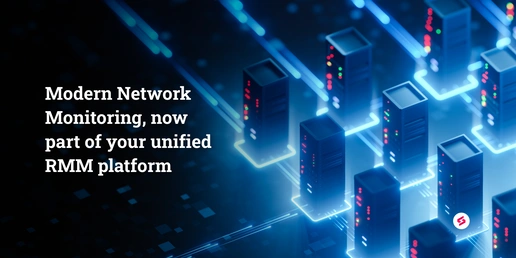Networks have advanced. Your monitoring should, too.
Imagine this.
You’re an IT admin, and you have a massive set of network devices to manage—routers, firewalls, switches, the whole works. It’s your job to make sure that they’re all running smoothly without any hiccups, and you’ll need all the help you can to make it happen.
You need to have a close watch over the network to ensure all the vital functions are working properly and any deviation in performance is promptly figured out and attended to.
Welcome to network monitoring, the process of constantly monitoring a computer network for failures and insufficiencies to ensure uninterrupted performance.
Now imagine this. Networks have evolved, applications have become more distributed, and infrastructures once considered impenetrable are falling prey to vicious cyberattacks every other day. As traditional monitoring tools fail to keep up with the needs of complex network environments, modern networking solutions emerged, providing advanced, proactive, and automation-driven network monitoring capabilities to help modern-day MSPs manage their networks successfully.
So, what does modern network monitoring look like? How does it differ from traditional monitoring?
Key features of modern network monitoring
Beyond basic monitoring
The traditional network monitoring solutions were designed for the primary objective of scanning and discovering the network components to keep them free of issues. However, the needs of monitoring have evolved over the years, from having to manage complex microservices to distributed architectures. Modern network monitoring offers advanced network observability including granular deep-packet analysis and traffic pattern observation for spotting intricate issues that might fall through the cracks otherwise.
Real-time visibility and proactive monitoring
Modern network monitoring goes beyond traditional periodic monitoring to offer real-time visibility into network performance. The real-time insights ranging from basic network health to critical metrics like data loss and latency issues so you can actively anticipate issues before they interrupt operations or escalate into business-critical problems. Modern businesses are all about effectively predicting problems rather than just solving them reactively. Modern network monitoring thus employs a proactive approach to help network administrators respond quickly to issues, ensuring optimal performance.
Unified monitoring capabilities
In order to get a holistic picture of your client environment, it’s important to bring critical network info closer to your tech stack, or better, within. As an MSP, you need complete visibility into a client environment to keep it humming, which becomes difficult if you use different tools to manage different components. A modern network monitoring solution centralizes the vital signs of all your critical components in one place, empowering you to get instant context and make informed decisions quickly.
Automation and AI-driven monitoring
Adding a layer of artificial intelligence and automation takes network monitoring to another level of modernity. In the era of decentralized operations, the ability to access critical networking information and receive alerts anywhere has become important for successful operations. With the use of machine learning algorithms, modern network monitoring tracks patterns, predicts issues, and raises instant alerts in real time to swiftly switch gears and correct course.
Dashboards and deeper visualizations
Modern network monitoring also enables MSPs to create custom dashboards and reports to identify problem characters and productivity-hogging sources. Some of the advanced network monitoring tools available today help you understand important events, analyze trends, and reveal new avenues for growth with detailed reports.
A focus on flexibility
Modern network monitoring solutions are designed to handle complex even as they grow in size and complexity. This helps MSPs maintain the control they have over their network and keep operations humming even as they expand, without having to invest in a more enterprisey tool.
The need to adapt
Network monitoring is an evolving field that calls for technology providers and users to adapt to the changing needs of the landscape. Further, as on-remise networks become a thing of the past and multi-cloud environments the norm, network monitoring will become more and more critical in ensuring business integrity, continuity, and success.
Adapting to the changing reality might just be the last choice standing between an MSP business leading at the forefront or waiting until they are swept into the wave of whatever comes next.





